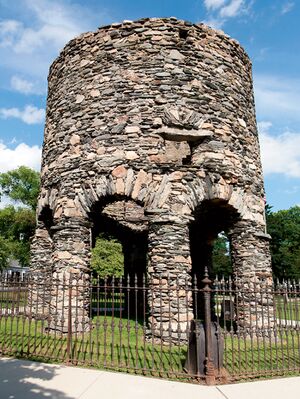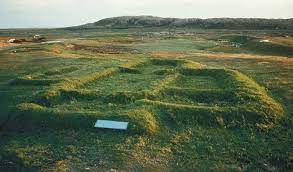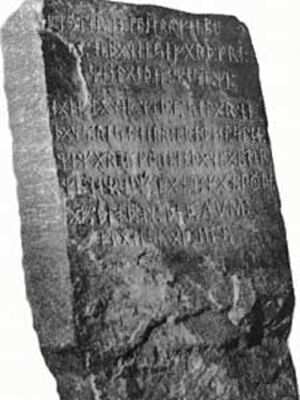Newport Tower
By Damian Gonzalez
The Newport Tower is roughly a 28 x 24 foot circular tower, sitting upon eight arched pillars. The name Newport Tower comes from the city of Newport, Rhode Island, where the tower is located. Records indicate that the tower was once used as a windmill[1], however there is some credible debate on whether or not the tower was built before its use as a mill.[2] Although no one is certainly sure where the tower came from or who built it, most credible Archaeologists trace it back to the 17th century. On the other hand, some alternative history and Pseudo-Archaeological narratives present the largely unsupported idea that perhaps the tower was built by early Norse settlers, or even the Templar Knights.

History of The Tower
Origins
The records of the Newport Tower can be traced back to 1677 at the earliest, in a deed for a cemetery in which the tower was referenced as "the stone mill"; likewise, in the same year, Governor Benedict Arnold referred to the tower as "[his] stone built windmill." [2] It would make sense for Governor Arnold to construct a Windmill around that time period considering the first and only Windmill on Rhode Island, built under Governor Eaton, had been destroyed by a storm in August, 1675[2], just 8 months prior to Governor Arnold's reference to the mill. However, there is no record of the construction of the tower, or when it was built, which is extremely odd considering how complete colonial era construction records are for Rhode Island.[2] Coincidently, the scarcely available records for the tower indicate that up to the year 1800, both the tower and the land it rested on belonged to Governor Arnold[4]--strengthening the possibility that it was Governor Benedict Arnold who ordered the erection of the tower. In addition to Governor Arnold's reference to the tower as "his" stone mill in his will, two other documents referenced the structure in that same year (1677),[4] however was almost never mentioned again in any sort of document for the next Century.[4]
Excavation
Legitimate, Archaeological, excavation in the ground around the tower began during the season of 1948-'49 by Archaeologist William Godfrey and his team.[5] Those who viewed the tower as Colonial in origin were strongly opposed to excavation of any kind,[4] seeing the project as a tremendous waste of money and time. Nevertheless, Godfrey and his team began their excavation in 1948, digging in spots distanced from the tower so as to not disturb fences, benches, wood, and concrete that were already in place around the tower.[4] In doing this, Archaeologists hoped to determine the strength of the tower's underpinnings by studying the entire area's geology, as well as find other related structures or significant cultural artifacts that would help them identify the age of the tower.[4]
Once the excavation began, Godfrey's team dug a long trench that went from the center of Touro Park all the way to the tower itself, where it passed between the columns of the tower on its southeastern side.[4] In searching the trench, almost no artifacts of any importance were found, nor was there evidence of any type of structure. As the team moved closer to the direct vicinity of the tower, they did come across some items that peaked Godfrey's curiosity. While excavating in the area directly around the tower, Godfrey's team came across a pistol flint (admittedly insignificant), a fragment of a clay pipe, fragment of orange pottery found underneath undisturbed soil, handblown glass, a nail, and another fragment of pottery, almost identical to the first but with a small piece of preserved glaze.[5]
This piece of pottery was immediately noticed by Dr. Hugh Hencken who was working on the dig, as he pointed out the striking resemblance in paste, glaze type, and interior finish of pottery found in Plymouth's John Howland House (built in 1628).[5], indicating that construction of the tower took place during some date in the Colonial period. While digging in another trench, Godfrey himself came across a heel boot footprint in the undisturbed soil[5]while searching the ground for evidence of the tools the builders of the tower used. This discovery held great importance since it, along with the rest of the artifacts, appeared in the colonial layer of soil right above that of the undisturbed soil[5], suggesting that construction of the tower took place during some date in the Colonial period.
Godfrey's Conclusions
Godfrey, along with his team, took into account all of the evidence gathered at Touro Park and noticed all of the items and fragments of tools discovered were found in the Colonial horizon of soil. Combined with the noticed similarities between pottery found at Newport, and Colonial-age pottery found at a different Archaeological site, Godfrey concluded that the tower had to have been built by Governor Benedict Arnold or a contemporary of his.[5] Since Godfrey's excavation, most Archaeologists agree the tower is indeed a 17th Century structure, however some legitimate debate exists in the general date of construction, and whether it was indeed Governor Arnold, or a predecessor that erected the tower.
Pseudo Archaeological Narratives
Although William Godfrey and the majority of Archaeologists place the construction of the Newport Tower in the Colonial era, very much conversation exists on whether or not the tower itself is older than previously thought.
Norse Origin
One of the most popular alternative origin stories to the Newport Tower argues that Vikings constructed the tower on one of their famous journeys to the Americas. As a result, many locals believed Godfrey would come across the remains of Norse Churches once he excavated underneath the concrete around the Newport Tower (no such ruins were found).[4]Although the Norse did in fact make trips to North America, absolutely no Archaeological evidence proves they went further South than the L'Anse aux Meadows site in Newfoundland, Canada.

The biggest proponent of the tower's Norse origin story comes as Hjalmar Holand, a Norwegian-American historian. Holand primarily centered around the hyper diffusionist argument that because the Newport Tower shared resemblance to 8-column churches found in Norway and Denmark,[2]they must come from the same source. In addition to this common hyper diffusionist thinking style, Holand also used a vast amount of measurements to try and prove that the builders of the tower used a different system of measurement than commonly used during the time period in which the tower was supposedly constructed.[7] Holand argued that the measurements of the tower did not align with those of the Colonial age, and instead matched those of Norse units.[7] In addition to this, Holand also relied heavily on the Plowden Petition, a 1632 petition requesting a grant from the Crown for Long Island and part of what is now continental United States.[4] In the petition, there is mention of a "round stone towr" that Holand believes is the Newport Tower. If this were indeed true, it would vastly change the age of the Newport Tower, however, further investigation into Holand and the ways in which he approached the history of the tower provides substantial problems.
Deconstructing The Norse Theory
Beginning with the assumptions about Norse church remains underneath the concrete sidewalks surrounding the tower, like a lot of Pseudo-Archaeology, it can be deconstructed when looking at the facts. As mentioned above, all it took was for real archaeologists to remove this concrete and excavate--to which Archaeologists found nothing,[4] let alone remains of a church.
The measurement argument, most notably conveyed by Holand, also lacks scientific validity as Godfrey noted in a response to an article written by Holand, how the measurements Holand used that matched that of Norse's were taken from the internal tower diameter, external diameter, diameter of the columns, and the height of the first floor [8]--none of which hold any significant value to the construction or understanding of the tower. In addition to this, William Godfrey also measured the tower shortly before he began excavating. Interestingly enough, the measurements Godfrey took himself were actually different than those written about by Holand. Godfrey found that the most commonly used measurement by Pseudo-Archaeologists, that of the distance from the first floor to the ground floor, is not only insignificant but when measured by him he found it measured almost exactly 9.5 English Feet.[8]This converted to the Norse system of measurement would total to just over 9'8",[8] an odd number to choose if measuring with that system. Therefore, when Godfrey and his team took significant measurements of the tower, not only did they match closely to colonial measurements, but they also failed to align with the Norse measurements Holand argued for. Measurements differ all over the tower, and just because certain measurements fit a specific narrative does not necessarily mean they all do. That being said, the tower also does not have a true center because it's not perfectly round, combined with the lack of specialized tools used to cut the stone, makes out for very uneven measurements throughout the structure, explaining why measurements vary throughout the tower.[8]
The second point of argument, and another contention of Holand's belief, bases itself partly in fact, as there really was a Plowden Petition in 1632 asking for a grant of land in the America's. However, although the petition mentions a "round stone towre", it fails to detail a location of the tower, as well as a clear indication of whether or not the tower already existed or was going to be built.[8] In addition, scholars doubt the Newport Tower was the one referenced in the 1632 petition due to the fact that the real Newport Tower lies well outside the measured square of land that Plowden petitioned.[8] Overall, it is important to keep in mind much of the minute details when looking at Pseudo Archaeological narrative of the Plowden Petition, as well as the theory of Norse construction at all. For example, the fact that the report was gathered at the height of debate between a Norse and Colonial origin alone raises suspicion,[4] creating an already existing bias that Norse sympathetics believed without question. Likewise, Holand himself was tremendously bias in Norse influence on the Americas, being Scandinavian himself. In addition to this, he was also a big proponent of the infamously faked Kensington Runestone,[4]

of which many people still believe is real thanks to people like Holand.
The final deconstructive piece of the Norse theory argues against the belief that Nordic runes can be found on the tower. On one of the stones of the tower, slight scratches can be seen that many proponents of a Norse origin believe are Viking runes left behind. Instead of plainly accepting these mysterious scratches as Viking runes, Newport Tower Museum director Jim Egan invited Dr. Henrik Williams, Director for the Center of Runology at Uppsala University in Sweden to examine the scratches. The expert opinion of Dr. Williams viewed the scratches on the rock of the tower as more likely man-made than not, however strongly opposed the idea that these were Runic, as they did not translate to anything readable.[10] Even if these inscriptions were meant to be runes, they would have very roughly translated to the letters "I I R S",[10] which does not read anything significant. Reinforcing this opinion, Dr. Williams also added that he had never seen any Viking structure that looked anything like the Newport Tower, saying "they did not make stone buildings at all like this."[10]
Knights Templar Theory and Deconstruction
The belief that the Knights templar constructed the Newport Tower as part of a settlement after a supposed escaped from European persecution relies heavily on the idea that there are astrological alignments in the tower, of which only the Knights Templar could have known. In the History Channel's "America Unearthed", a show aimed at proving alternative history, host Scott Woltor argues that the Templars worshipped Venus and aligned the tower with the planet Venus.[11] Waltor also found evidence of Cumberlandite stone used in the tower, which he deemed as the "stone of Venus"[11], as well as extremely rare for use in building. However, what he fails to mention is the fact that Cumberlandite is extremely common in that area, and is in fact the State Stone of Rhode Island.[12] Not only this, but almost no scholarly articles or reports exist on the Knights Templar and their idolization of Venus.
Waltor and others also argue that the tower has "precise" measurements that are not a mistake, with windows that line up to the planet Venus. This comes as a hard thing to believe considering the tower itself is not perfectly round, nor does it have a true center. Also, when Waltor looked for alignments between the planet and window he found that it was close but not accurately alined, to which he contributed the change in the tilt of the Earth over time as a cause. The most cunning piece of evidence for astronomical alignment proves itself in the way in which the Sun reflects off of a central, oval-shaped stone on the Summer Solstice. The way in which the Sun reflects off of the stone is in itself quite remarkable and one cannot help but think it might have been done on purpose. However, Waltor previously stated that the alignments between the window's and Venus were off due to the change in the Earth's tilt over time. That being said, this would have to mean that the Sun too would no longer hit this same stone[13] as the change would not only affect one alignment, but all of them. Nevertheless, this simply acts as another example of people using certain pieces of information that prove their narrative, and ignoring others that disprove it, synonymous with Pseudo Archaeological practices.
In addition to the astronomical implications, Waltor and other proponents argue that the keystone of the tower looks like that of those used by Freemasons, thus pointing to Masonic origins.

The Keystone on the Newport Tower is roughly shaped similar to that of a real Keystone, however so roughly shaped that one cannot tell whether or not it was carved intentionally, or simply to support the structure of the tower.[13] All in all, the biggest piece of evidence against the theory of Templar Knights building the tower lies with the outright absence of Archaeological evidence of Templars ever being there. Adding to this, the only pieces of "evidence" offered by alternative theorists rely on pure assumptions rather than fact.
Conclusion
All in all, the Pseudo Archaeological narratives surrounding the Newport Tower share common patterns that can be seen with other similar beliefs. For example, Nationalism plays a tremendous part in this story, as proponents of Viking construction of the tower such as Scandinavian born Hjalmar Holand worked their entire lives to prove Norse influence in the Americas. As a result, this lead to him and others using certain pieces of evidence that helped their narrative while hiding others, as well as making vast assumptions on vague details of historical documents. Although not necessarily nationalistic in nature, the same patterns of selective information can be seen in the case of the Templar Knights theory in the ways in which certain alignments--like the oval shaped stone-- still to this day line up perfect, while those of Venus do not. Like Holand's work, proponents of the Templar theory use bits of information that exclusively helps their cause while ignoring the rest. As a result, this leads to great amounts of confusion surrounding certain historical accounts, as seen with the Kensington Runestone and how its Nationalist motivations have convinced many people of this hoax. To counter this, scholars and citizens must continue to use and execute scientific methods, and facts instead of assumptions, to uncover our true past.
References
- ↑ Hertz, Johannes (1997) "Round Church or Windmill? New light on the Newport Tower," Newport History: Vol. 68 : Iss. 235 , Article 2. Available at: https://digitalcommons.salve.edu/newporthistory/vol68/iss235/2
- ↑ 2.0 2.1 2.2 2.3 2.4 Pohl, Frederick J. “Was the Newport Tower Standing in 1632?” The New England Quarterly, vol. 18, no. 4, New England Quarterly, Inc., 1945, pp. 501–06, https://doi.org/10.2307/361066.
- ↑ Cohen, Thornton. “Newport Tower.” Yankee Magazine, 2016, https://newengland.com/yankee-magazine/travel/rhode-island/newport/newport-tower/. Accessed 2021.
- ↑ 4.00 4.01 4.02 4.03 4.04 4.05 4.06 4.07 4.08 4.09 4.10 4.11 Godfrey, William S. “The Archaeology of the Old Stone Mill in Newport, Rhode Island.” American Antiquity, vol. 17, no. 2, Society for American Archaeology, 1951, pp. 120–29, https://doi.org/10.2307/277246,
- ↑ 5.0 5.1 5.2 5.3 5.4 5.5 Godfrey, William S. “NEWPORT TOWER II.” Archaeology, vol. 3, no. 2, Archaeological Institute of America, 1950, pp. 82–86, http://www.jstor.org/stable/41662368.
- ↑ Ferguson, Rob https://www.archaeologicalconservancy.org/searching-for-vikings/. Accessed 2021.
- ↑ 7.0 7.1 Holand, Hjalmar R. “THE AGE OF THE NEWPORT TOWER.” Archaeology, vol. 4, no. 3, Archaeological Institute of America, 1951, pp. 155–58, http://www.jstor.org/stable/41662990.
- ↑ 8.0 8.1 8.2 8.3 8.4 8.5 Godfrey, William S. “Vikings in America: Theories and Evidence.” American Anthropologist, vol. 57, no. 1, [American Anthropological Association, Wiley], 1955, pp. 35–43, http://www.jstor.org/stable/665785.
- ↑ “Kensington Runestone.” Minnesota Public Radio, 2009. Accessed 2021.
- ↑ 10.0 10.1 10.2 Creedon, Marc, director. Runologist Henrik Williams Examines The Newport Tower. YouTube, YouTube, 13 Dec. 2015, https://www.youtube.com/watch?v=CPdEw7-fwho. Accessed 10 Dec. 2021.
- ↑ 11.0 11.1 America Unearthed, Season 1 Episode 12.” History Channel, 2013, Accessed 2021.
- ↑ “State Symbols.” RI.gov: Rhode Island Government, https://www.ri.gov/facts/factsfigures.php.
- ↑ 13.0 13.1 Colavito, Jason. “Review of America Unearthed S01E12 ‘America's Oldest Secret.’” JASON COLAVITO, https://www.jasoncolavito.com/blog/review-of-america-unearthed-s01e12-americas-oldest-secret.
- ↑ “Guide: State Symbols.” PA.Gov, 23 Apr. 2019, https://www.pa.gov/guides/state-symbols/.